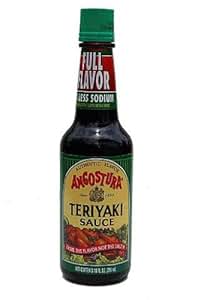Teriyaki sauce is a popular condiment in many Asian cuisines, known for its sweet and savory flavor profile. However, traditional teriyaki sauces can be high in sodium, which poses health risks for individuals monitoring their salt intake. Fortunately, making your own low sodium teriyaki sauce at home is not only simple but also allows you to control the ingredients, ensuring a healthier meal. This article will guide you through the process of creating a delicious low sodium teriyaki sauce, explore its benefits, and provide tips for incorporating it into your meals.
Understanding Teriyaki Sauce

Before diving into the recipe, it’s essential to understand what teriyaki sauce is and the role of its primary ingredients. Traditional teriyaki sauce typically includes:
- Soy sauce
- Sugar or honey
- Mirin (sweet rice wine)
- Garlic and ginger
These ingredients combine to create a thick, rich sauce that enhances the flavors of grilled meats, vegetables, and stir-fries. However, the sodium content in regular soy sauce can be quite high, with some brands containing up to 1,000 mg of sodium per tablespoon.
The Importance of a Low Sodium Diet
Reducing sodium intake is crucial for maintaining overall health. High sodium levels can lead to various health issues, including:
- High blood pressure
- Heart disease
- Stroke
- Kidney problems
According to the Centers for Disease Control and Prevention (CDC), about 70 million Americans have high blood pressure, a condition that can be exacerbated by excessive sodium consumption. Therefore, creating a low sodium alternative to your favorite sauces is a step towards better health.
Ingredients for Low Sodium Teriyaki Sauce

To make a delicious low sodium teriyaki sauce, you will need the following ingredients:
- 1/2 cup low sodium soy sauce (or a gluten-free alternative)
- 1/4 cup honey or maple syrup
- 2 tablespoons rice vinegar
- 1 tablespoon cornstarch (optional, for thickening)
- 2 cloves garlic, minced
- 1 teaspoon fresh ginger, grated
- Sesame seeds (optional, for garnish)
Low sodium soy sauce is the cornerstone of this recipe, providing the umami flavor without the excessive salt. Honey or maple syrup adds sweetness, balancing the saltiness of the soy sauce while also providing a healthier sugar alternative.
Step-by-Step Instructions to Make Low Sodium Teriyaki Sauce

Creating your low sodium teriyaki sauce is straightforward. Follow these steps to prepare it:
- Combine Ingredients: In a small saucepan, combine the low sodium soy sauce, honey (or maple syrup), rice vinegar, minced garlic, and grated ginger. Stir well to mix all the ingredients.
- Heat the Mixture: Place the saucepan over medium heat. Bring the mixture to a gentle simmer, stirring occasionally.
- Thicken the Sauce (Optional): If you prefer a thicker sauce, dissolve the cornstarch in a tablespoon of water to create a slurry. Add the slurry to the saucepan and continue to simmer for an additional 2-3 minutes or until the sauce thickens to your desired consistency.
- Cool and Store: Once the sauce has thickened, remove it from heat and let it cool. Transfer it to an airtight container. The sauce can be stored in the refrigerator for up to two weeks.
Using Your Low Sodium Teriyaki Sauce

Your homemade low sodium teriyaki sauce is versatile and can be used in various dishes. Here are some ideas:
- Marinade: Use the sauce as a marinade for chicken, beef, or tofu. Allow your protein to marinate for at least 30 minutes before cooking for the best flavor.
- Stir-Fry: Add the sauce to your favorite stir-fried vegetables and protein for a quick and healthy meal.
- Dipping Sauce: Serve the sauce as a dipping sauce for spring rolls, dumplings, or grilled meats.
- Glaze: Brush the sauce onto grilled meats during the last few minutes of cooking for a flavorful glaze.
Health Benefits of Homemade Low Sodium Teriyaki Sauce

Making your own low sodium teriyaki sauce offers several health benefits:
- Control over Ingredients: You can choose organic or non-GMO ingredients, avoiding preservatives and artificial flavors.
- Customization: Adjust sweetness or spice levels according to personal preference, creating a sauce that suits your taste.
- Healthier Alternatives: Using honey or maple syrup instead of refined sugars leads to a more nutritious sauce.
Case Studies: Healthier Eating Through Homemade Sauces

Many individuals and families have reported positive changes in their health and wellness after switching to homemade sauces. A study published in the Journal of Nutrition found that participants who prepared their meals at home were less likely to consume excess sodium and sugar compared to those who relied on processed foods. Furthermore, families who engaged in cooking together not only improved their dietary habits but also strengthened family bonds.
Making your own low sodium teriyaki sauce at home is an excellent way to enhance your meals while prioritizing your health. By using simple, wholesome ingredients, you can create a flavorful sauce that meets your dietary needs and preferences. The benefits of reducing sodium in your diet are significant, contributing to better heart health and overall well-being.
In summary, making low sodium teriyaki sauce is a straightforward process that empowers you to take control of your eating habits. With just a few ingredients and minimal effort, you can create a delicious sauce that can be used in various dishes, making healthy eating enjoyable and sustainable. Start experimenting today, and enjoy the delicious flavors of homemade teriyaki sauce without the extra sodium!





